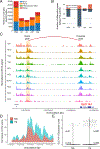Interneuron Loss and Microglia Activation by Transcriptome Analyses in the Basal Ganglia of Tourette Disorder
- PMID: 39892689
- PMCID: PMC12255533
- DOI: 10.1016/j.biopsych.2024.12.022
Interneuron Loss and Microglia Activation by Transcriptome Analyses in the Basal Ganglia of Tourette Disorder
Abstract
Background: Tourette disorder (TS) is characterized by motor hyperactivity and tics that are believed to originate in the basal ganglia. Postmortem immunocytochemical analyses has revealed decreases in cholinergic (CH), as well as parvalbumin and somatostatin GABA (gamma-aminobutyric acid) interneurons (INs) within the caudate/putamen of individuals with TS.
Methods: We obtained transcriptome and open chromatin datasets by single-nucleus RNA sequencing and single-nucleus ATAC sequencing, respectively, from caudate/putamen postmortem specimens of 6 adults with TS and 6 matched normal control subjects. Differential gene expression and differential chromatin accessibility analyses were performed in identified cell types.
Results: The data reproduced the known cellular composition of the human striatum, including a majority of medium spiny neurons (MSNs) and small populations of GABA-INs and CH-INs. INs were decreased by ∼50% in TS brains, with no difference in other cell types. Differential gene expression analysis suggested that mitochondrial oxidative metabolism in MSNs and synaptic adhesion and function in INs were both decreased in subjects with TS, while there was activation of immune response in microglia. Gene expression changes correlated with changes in activity of cis-regulatory elements, suggesting a relationship of transcriptomic and regulatory abnormalities in MSNs, oligodendrocytes, and astrocytes of TS brains.
Conclusions: This initial analysis of the TS basal ganglia transcriptome at the single-cell level confirms the loss and synaptic dysfunction of basal ganglia INs, consistent with in vivo basal ganglia hyperactivity. In parallel, oxidative metabolism was decreased in MSNs and correlated with activation of microglia cells, which is attributable at least in part to dysregulated activity of putative enhancers, implicating altered epigenomic regulation in TS.
Keywords: Human; Interneurons; Microglia; Multiomics; Striatum; Tourette disorder.
Copyright © 2025 Society of Biological Psychiatry. Published by Elsevier Inc. All rights reserved.
Conflict of interest statement
Disclosure
The authors declare no competing interest.
Figures



Update of
-
Interneuron loss and microglia activation by transcriptome analyses in the basal ganglia of Tourette syndrome.bioRxiv [Preprint]. 2024 May 10:2024.02.28.582504. doi: 10.1101/2024.02.28.582504. bioRxiv. 2024. Update in: Biol Psychiatry. 2025 Aug 1;98(3):260-270. doi: 10.1016/j.biopsych.2024.12.022. PMID: 38464084 Free PMC article. Updated. Preprint.
References
MeSH terms
Grants and funding
LinkOut - more resources
Full Text Sources
Medical

